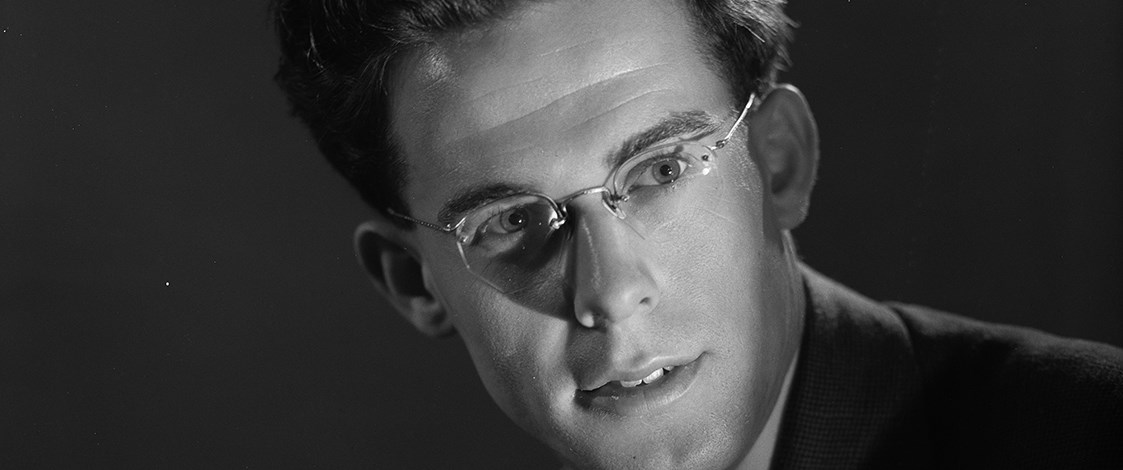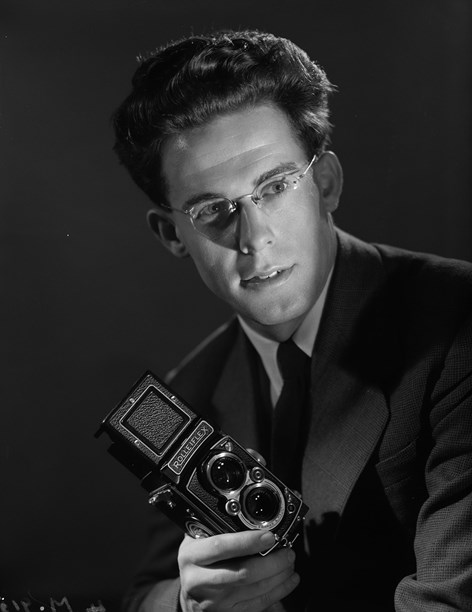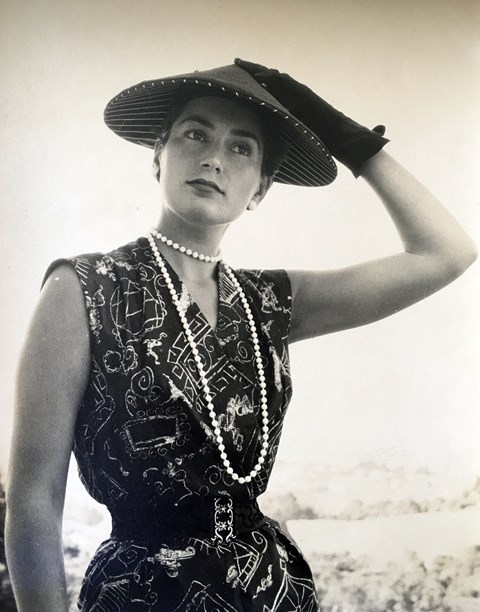Stories
Ted Mahieu
1929-

Ted Mahieu was one of a group of creative Dutch immigrants who sailed to New Zealand in the early 1950s and set up home in the Auckland bush suburb of Titirangi. That group included designers Rosemarie Muller, Frank and Carla Carpay, Peter Smeele, Robert Leek and his sister, model Else van den Muysenbergh.
At that time in his early 20s, Ted was hoping to make a name for himself as a fashion photographer but instead found himself working for minimum pay as a photo engraver – a discipline he had studied in the Netherlands.
By all accounts he had an engaging personality. Else van den Muysenbergh who was later immortalised by Ted in some striking fashion shots, recalls him as being a "popular and terrific guy."
Ted made the acquaintance of professional photographer, Clifton Firth, whose studio at 110 Queen Street specialised in fashion and glamour portraits. It was also a meeting place for Auckland’s leading literary, theatrical and academic figures – the literati and glitterati of the time. Clifton Firth’s portrait of a youthful Ted proudly holding his high-end Rolleiflex camera reveals a young man of serious intent.

Photo of Ted Mahieu by Clifton Firth. Photo courtesy of Auckland Libraries Heritage Collections, 34-M915.
It was Clifton Firth who pulled the necessary strings to release Ted from his bonded photo engraving job. In the early 1950s there were huge innovations in both photographic equipment and printing machines, especially the development of technology for colour photography. Ted went to work for Sparrow Industrial Pictures Ltd. Owned by another leading Auckland commercial photographer and businessman, Bill Sparrow, this thriving Auckland business produced everything from slick images for advertising to documentary records of building projects and also photographed the window displays at department stores including Smith & Caughey's and Milne & Choyce.
Here Ted began to fulfil his dream of being a professional photographer, nurturing his passion not only for fashion but also for architectural photography. He is recorded as working with the exceptionally talented Czechoslovakian refugee architect, Vlad Cacala, but it is for his fashion photography that Ted is best remembered in New Zealand.
Most women’s fashion photography in the early 1950s was catalogue work for the big department stores – Smith & Caughey, Milne & Choyce, John Courts, George Courts and Farmers. But independent designers such as Rosemarie Muller and Babs Radon were also styling and photographing their collections using professional models as modelling was becoming a sustainable career for a number of enterprising young women.
In 1957 Ted left Sparrow and went out on his own as a commercial and fashion photographer setting up Studio 57 in Parnell with Lyn Anderson.
Ted took all the photos for the promotional brochure of a major travelling fashion parade sponsored by the NZ Textile and Garment Federation in July 1957. The touring show, compered by Paddy Walker, featured models Else van den Muysenbergh, Kay Reilly and Mira Szaszy (later to become Auckland University’s first Māori female graduate and President of the Māori Women’s Welfare League).
Else remembers Ted as an in demand and focused professional, intent on getting the shots he wanted. He didn’t use a lot of expensive equipment and on most shoots the models did their own make-up and used their own accessories. During one memorable shoot Ted literally turned the room in a private house upside down by moving all the furniture to get the set-up he envisaged. "I felt really embarrassed," Else said.
1957 was a peak year for Ted. Robert Leek recalls a Christmas party that year at Rosemarie Muller’s, the guest list of which could almost be seen as a cast call for the creative Dutch émigré community. Robert recalls that "key among her guests was the influential fashion photographer Ted Mahieu".

Ted Mahieu often photographed fellow Dutch émigré and model Else van den Muysenbergh.
Another model Ted often photographed was Fleur Young. Fleur worked with Ted Mahieu in her early modelling years. She remembers him with great affection and they stayed in contact after Mahieu left New Zealand. "He was just a super guy and a hard worker," she remembers. "And his lighting was always special."

Ted Mahieu photograph of Fleur Young, 1958. Image © Ted Mahieu.
Ted photographed Fleur many times modelling for Plummer Hats, including the photos for a Vogue ad from Summer 1959.
Fleur Young modelling for Plummer Hats. Photos by Ted Mahieu.
In January 1960, Focalplane, the newsletter of the Auckland Photographic Society, describes an expedition with the North Shore Photographic Society where Ted gave a "hilarious fifty-minute speech" on 'Fashion and Architecture'. "Ted’s advice was 'photography should always be fun' – and it certainly was fun hearing him tell about his work taking photos of models modelling fashions for the trade."
In the October 1960 issue of Focalplane it was noted that Ted was the guest judge for that month’s competition. His standards were obviously high as he made only four acceptances out of 21 entries, reportedly giving the members a good shake up. "Ted’s advice is to give a little more thought to the prints; in the subject, story and arrangement, and try and get away from the everyday obvious version."
Sometime in the mid 1960s Ted Mahieu left New Zealand to travel abroad. Fellow photographer, the late Steve Rumsey, told student writer, Abbey Henry, that: "He was known as a flamboyant, outgoing photographer but New Zealand was too small for Ted Mahieu. He thought he was destined to be greater."
In a 1998 interview with the same writer, Else van den Muysenbergh said: "The last I heard of Ted Mahieu was three years ago when he returned to New Zealand for a holiday. Ted told me he was working in San Francisco as an aerial photographer."
Online searches find Ted amongst a "crack team of writers and photographers" on a June 1968 National Geographic assignment about forest fires. In other searches his name turns up as photographer for a book on trees and a series of shots of jazz musician Dizzy Gillespie in the 1970s.
An E-bay seller of Ted Mahieu portraits of Frank Sinatra and Carmen McRae, Russ Levin, wrote: "Ted has travelled the world to capture great images for over 50 years. One of his images of the Taj Mahal set the standard for that subject. He is an honoring life member of American Society of Media Photographers (ASMP). He has photographed world leaders to Hollywood celebrities, and a few strip clubs. He also had the opportunity to work in Ruth Bernhard's studio with a few of her models."
It seems that New Zealand was indeed a little small for Ted Mahieu.
Text by Katherine Findlay. Banner image by Clifton Firth, courtesy of Auckland Libraries Heritage Collections, 34-M915.
Published August 2018, updated August 2019.